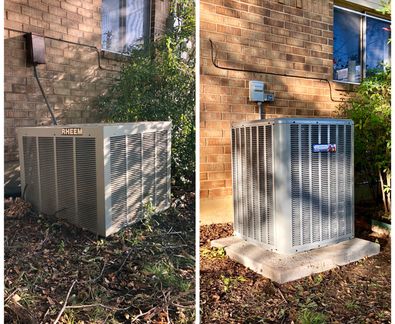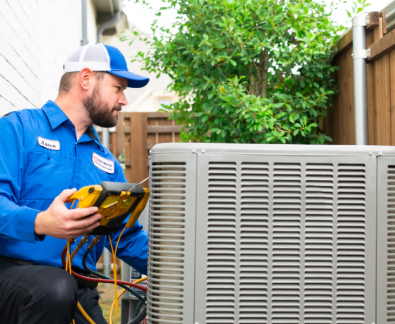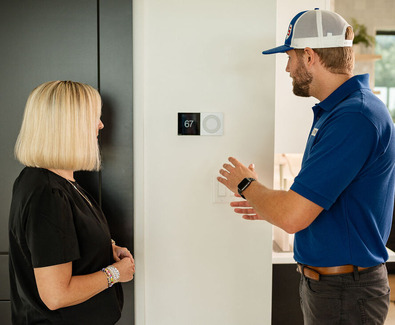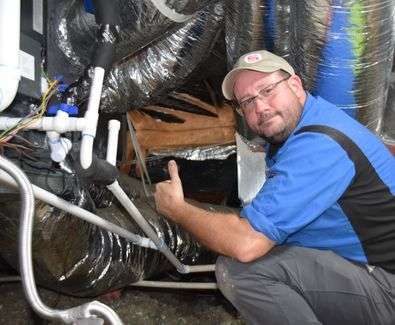AC Service Experts in Denton, TX
Expert HVAC Services in Denton, TX
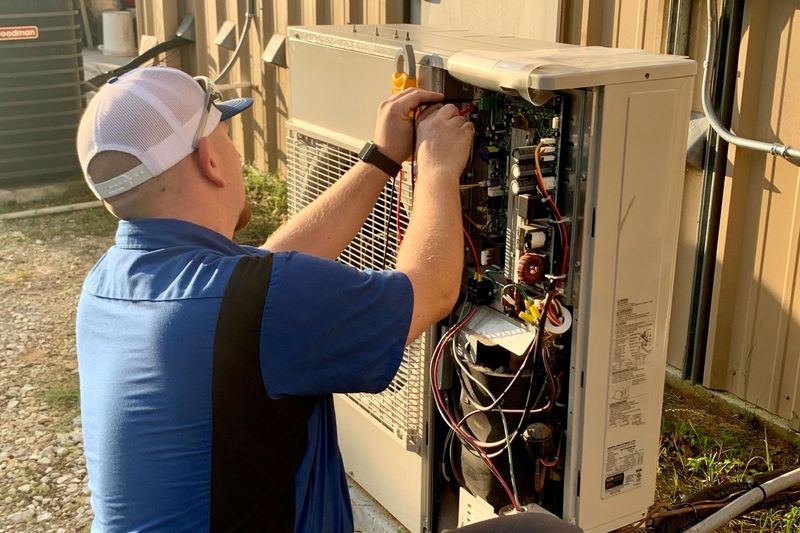
Our team at Strittmatter strives to be the go-to HVAC experts serving Denton and the surrounding areas. We understand that your comfort and peace of mind are top priorities, and that’s why we’re committed to delivering exceptional heating, ventilation, and air conditioning services. You don’t have to worry about those hot Texas summer days or chilly winter nights, as our HVAC team can ensure that your home is just the way you like it.
With a team of highly skilled technicians and years of experience, we offer a wide range of HVAC solutions, from precision installations and energy-efficient upgrades to fast and reliable repairs. We take pride in keeping your HVAC systems in peak condition, providing the comfort you deserve while optimizing energy efficiency to save you money.
At Strittmatter, your satisfaction is our priority, and we’re dedicated to delivering top-tier service with a friendly smile. Contact us today to schedule an appointment and experience the difference of working with the best HVAC company in Denton, TX.
Why Choose Our Residential Air Conditioning Service?
At Strittmatter, we aim to maintain healthy indoor air quality in our clients’ homes. Our company is proven to be one of the most reliable residential air conditioning installers and HVAC repair teams in Texas.
Proven Experience: Since 1980, we have served the Texas region with reliable HVAC installation and repair services.
Reliable Service: We’re here when you need us. Call our number at 940-246-2075 and schedule your service today. Your comfort is our business, and we take it seriously.
Energy Efficiency: A broken HVAC unit can cause a rise in energy bills. Our residential air conditioning maintenance team is committed to helping you reduce your energy bills by repairing your HVAC unit both reliably and affordably. We can also offer ductless mini-split services to help make your system more energy efficient.
Quality Assurance: Our team is fully licensed and certified, and we stand behind the quality of our work. We use top-quality products and materials to ensure long-lasting HVAC solutions.
Experience unmatched comfort and service with Strittmatter. We’re your trusted HVAC partner, ready to keep your home cozy year-round. Contact us today for all your heating and cooling needs in Denton, TX!
Our Highly Trained AC Techs Can Assist
Families With the Following Services and More
System replacements
Sometimes, it’s time to say goodbye to an old system and get something new. We know this is costly and are here to provide the best options for your home and budget.
AC Service
We provide high quality AC service for all kinds of systems from central units to ductless mini-splits. Our services include repairs, maintenance, installments, inspections and replacements.
Preventive Maintenance
When you schedule regular preventative maintenance, you are protecting your air conditioning systems from unexpected damage and repairs. We provide high quality preventative maintenance that will be sure to protect your equipment and keep it running for years to come.
Indoor Air Quality
We provide many air conditioning services and installations that can improve your indoor air quality. Filter replacements, UV light installation, dehumidifier/humidifier installation and system cleaning are only a few of these excellent services guaranteed to get you breathing easier.
Energy Savings
The best way to save money on your energy bill is to increase the efficiency of your air conditioning systems. Through high SEER-rated system installations, preventative maintenance, more efficient accessory parts and more, we can help you save money on your monthly energy bill.
Air conditioning
Your cooling system cycles refrigerant through various mechanisms to lower the temp in your home. If a motor, valve, fan or electrical connection breaks down, you need air conditioning repair.
Indoor Zoning
Your indoor air should be a consistent temperature. If it isn’t, we can perform expert indoor zoning services to optimize air flow and improve indoor air quality.
Heat Pump Repair
Heat pumps work in your HVAC system both for heating and cooling purposes. Your system can’t function if a heat pump breaks down: call on us for diagnosis and repairs.
Professional Air Duct Cleaning
Air ducts accumulate debris, dust and allergens over time. This can pose a health risk to your family. If you suspect yours are dirty, we can inspect and suggest the right course for cleaning.
Temperature Balancing
Your home shouldn’t have hot spots. This could point to a failure somewhere in your HVAC system or just mean that you need ducts cleaned, vents cleaned or other maintenance performed. We can figure it out and take care of it.
Smart Home Options
Integrating with technology is an upgrade many homeowners are making. If you want to control your home at the touch of a button, we can install systems that make your life easier.
Safety Inspections
When was the last time your HVAC or other systems were inspected? Getting regular inspections from qualified professionals can prevent major malfunctions.
Seasonal Maintenance
Every year, your home undergoes variances in humidity and climate as well as simply aging. Protect your systems from needing major repairs by getting minor issues taken care of.
Contact us to get an expert to your home for any of the services above and more.
Don’t suffer through a scorching Texas day with a malfunctioning AC unit. When your air conditioning system needs expert attention, turn to the trusted professionals at Strittmatter Plumbing, Heating, and AC. We’ve got you covered for all your cooling needs, ensuring you stay comfortable year-round. Contact us today at 940-246-2075 to schedule a service or get the quick assistance you deserve.
Air Conditioning Services
- Seasonal System Maintenance
- Air Conditioning Services
- Air Conditioner Repair
- High Efficiency AC Installation
- Heat Pumps
- Compressor Repair
- Air Conditioner Service and Cleaning
- Condensate Drain Lines
- Indoor Air Quality
- Coil and Duct Sanitation
- Air Purification/ Sterilization
- Duct Cleaning
- Duct Repair/ Reroute/ Modification
- Antimicrobial Ductwork
- Antimicrobial Duct Liner
- Home Protection: Smoke Alarms, CO Detectors
- Whole Unit Surge Protector
- Whole House Dehumidification
- Whole House Humidification
- WIFI / Smart Thermostats
- Residential Zoning Systems
- Ductless Solutions
- Ductless Mini-Split Systems
- Duct Sealing/ Home Efficiency
- Thermostat Service
- Filter Replacement
- Attic Insulation
- 100% Guaranteed Satisfaction
- Upgraded Air Filtration Systems: 4″ Air Filtration System

